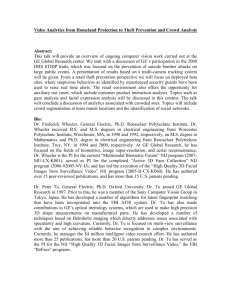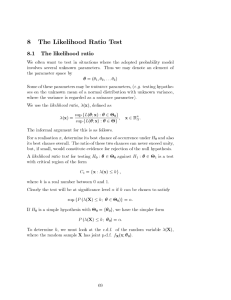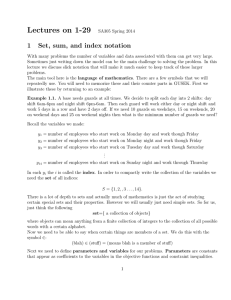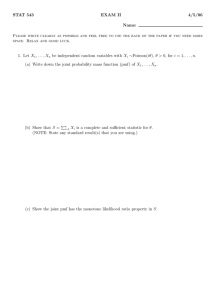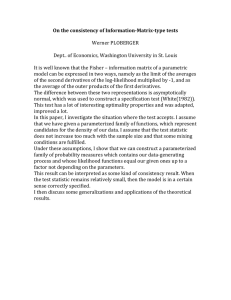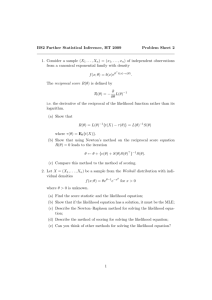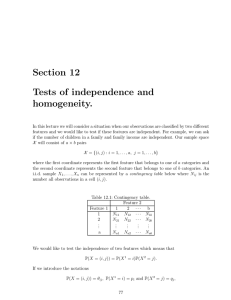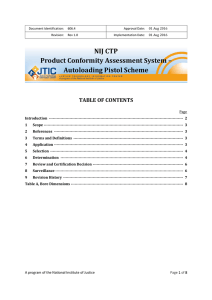Lecture 26 26.1 Test of independence.
advertisement
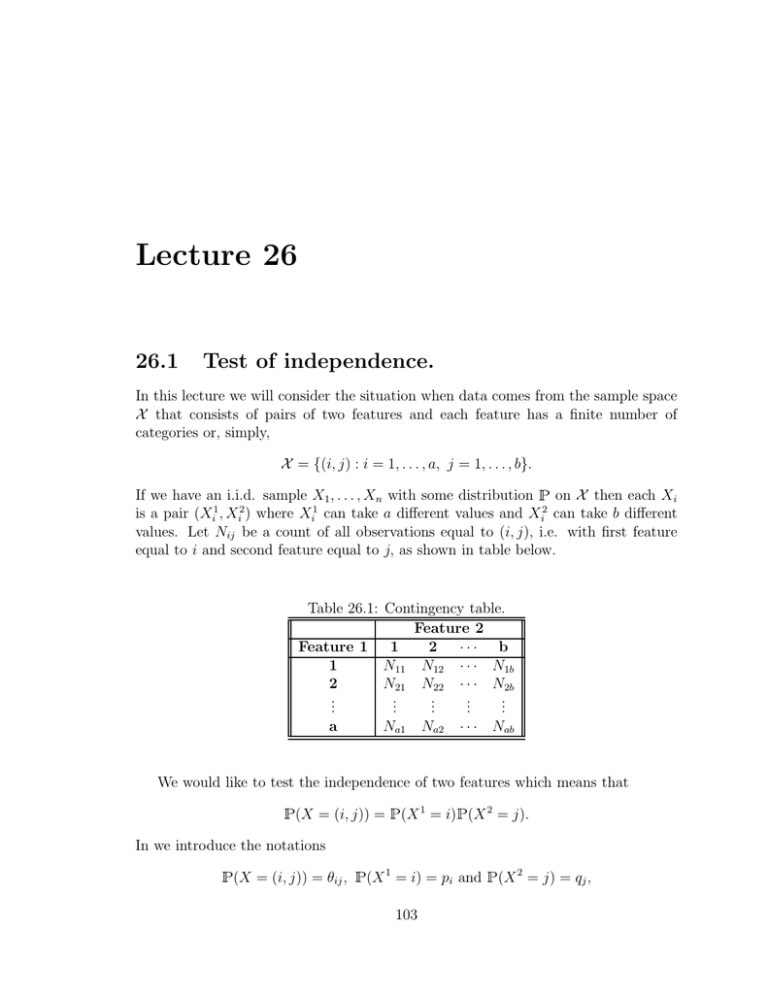
Lecture 26
26.1
Test of independence.
In this lecture we will consider the situation when data comes from the sample space
X that consists of pairs of two features and each feature has a finite number of
categories or, simply,
X = {(i, j) : i = 1, . . . , a, j = 1, . . . , b}.
If we have an i.i.d. sample X1 , . . . , Xn with some distribution on X then each Xi
is a pair (Xi1 , Xi2 ) where Xi1 can take a different values and Xi2 can take b different
values. Let Nij be a count of all observations equal to (i, j), i.e. with first feature
equal to i and second feature equal to j, as shown in table below.
Table 26.1: Contingency table.
Feature 2
Feature 1 1
2 ··· b
1
N11 N12 · · · N1b
2
N21 N22 · · · N2b
..
..
..
..
..
.
.
.
.
.
a
Na1
· · · Nab
Na2
We would like to test the independence of two features which means that
(X = (i, j)) =
(X 1 = i) (X 2 = j).
In we introduce the notations
(X = (i, j)) = θij ,
(X 1 = i) = pi and
103
(X 2 = j) = qj ,
104
LECTURE 26.
then we want to test that for all i and j we have θij = pi qj . Therefore, our hypotheses
can be formulated as follows:
H1 : θij = pi qj for some (p1 , . . . , pa ) and (q1 , . . . , qb )
H2 : otherwise
Of course, these hypotheses fall into the case of composite χ2 goodness-of-fit test from
previous lecture because our random variables take
r =a×b
possible values (all pairs of features) and we want to test that their distribution comes
from the family of distributions with independent features described by the hypothesis
H1 . Since pi s and qj s should add up to one
p1 + . . . + pa = 1 and q1 + . . . + qb = 1
one parameter in each sequence, for example pa and qb , can be computed in terms of
other probabilities and we can take (p1 , . . . , pa−1 ) and (q1 , . . . , qb−1 ) as free parameters
of the model. This means that the dimension of the parameter set is
s = (a − 1) + (b − 1).
Therefore, if we find the maximum likelihood estimates for the parameters of this
model then the chi-squared statistic:
T =
X (Nij − np∗i qj∗ )2
→ χ2r−s−1 = χ2ab−(a−1)−(b−1)−1 = χ2(a−1)(b−1)
∗ ∗
np
q
i j
i,j
converges in distribution to χ2(a−1)(b−1) distribution with (a − 1)(b − 1) degrees of
freedom. To formulate the test it remains to find the maximum likelihood estimates
of the parameters. We need to maximize the likelihood function
Y
Y P Nij Y P N
Y N Y N
qj +j
(pi qj )Nij =
pi j
qj i ij =
pi i+
i,j
i
j
i
j
where we introduced the notations
Ni+ =
X
Nij
j
for the total number of observations in the ith row or, in other words, the number of
observations with the first feature equal to i and
X
N+j =
Nij
i
105
LECTURE 26.
for the total number of observations in the jth column or, in other words, the number
of observations with the second feature equal to j. Since pi s and qj s are not related to
each other it isQ
obvious thatQmaximizing the likelihood function above is equivalent
N
N
to maximizing i pi i+ and j qj +j separately. Let us not forget that we maximize
given the constraints that pi s and qj s add up to 1 (otherwise, we could let them be
equal to +∞). Let us solve, for example, the following optimization problem:
Y
maximize
Ni+
pi
given that
i
a
X
pi = 1
i=1
or taking the logarithm
maximize
X
Ni+ log pi given that
a
X
pi = 1.
i=1
We can use the method of Lagrange multipliers. If we consider the function
L=
X
Ni+ log pi − λ(
a
X
i=1
pi − 1)
then we need to find the saddle point of L by maximizing it with respect to pi s and
minimizing it with respect to λ. Taking the derivative with respect to pi we get
∂L
Ni+
Ni+
=0⇒
= λ ⇒ pi =
∂pi
pi
λ
and taking the derivative with respect to λ we get
a
X
∂L
=0⇒
pi = 1.
∂λ
i=1
Combining these two conditions we get
X
pi =
X Ni+
λ
=
n
=1⇒λ=n
λ
and, therefore, we get that the MLE for pi :
p∗i =
Ni+
.
n
qj∗ =
N+j
.
n
Similarly, the MLE for qj is:
106
LECTURE 26.
Therefore, chi-square statistic T in this case can be written as
T =
X (Nij − Ni+ N+j /n)2
Ni+ N+j /n
i,j
and the decision rule is given by
δ=
H1 : T ≤ c
H2 : T > c
where the threshold is determined from the condition
χ2(a−1)(b−1) (c, +∞) = α.
Example. In 1992 poll 189 Montana residents were asked were asked whether
their personal financial status was worse, the same, or better than one year ago. The
opinions were divided into three groups by the income rage: under 20K, between 20K
and 35K, and over 35K. We would like to test if the opinion was independent of the
income range at the level of significance α = 0.05.
Table 26.2: Montana outlook poll.
b=3
a=3
Worse Same Better
≤ 20K
20
15
12
47
(20K, 35K)
24
27
32
83
≥ 35K
14
22
23
59
58
64
67
189
The chi-square statistic is
T =
47×58 2
)
189
47×58
189
(20 −
+...+
67×59 2
)
189
67×59
189
(23 −
= 5.21
and the threshold c:
χ2(a−1)(b−1) (c, +∞) = χ24 (c, ∞) = α = 0.05 ⇒ c = 9.488.
Since T = 5.21 < c = 9.488 we accept the hypotheses H1 that the opinion is independent of the income range.
